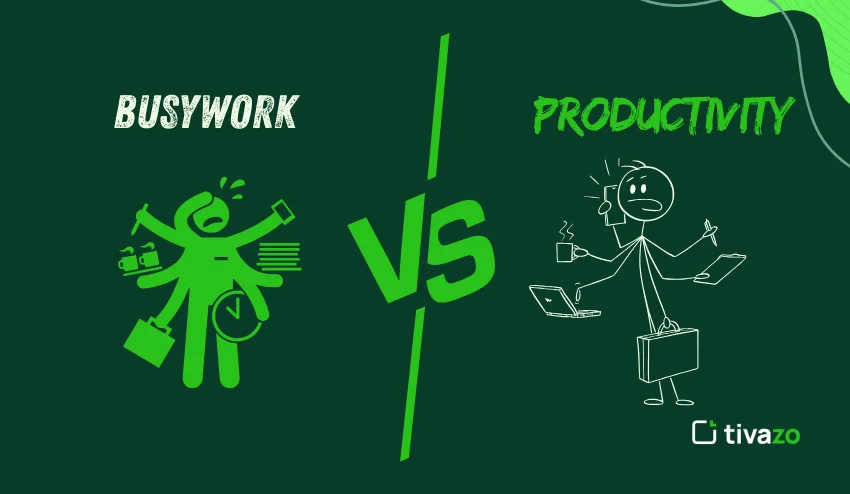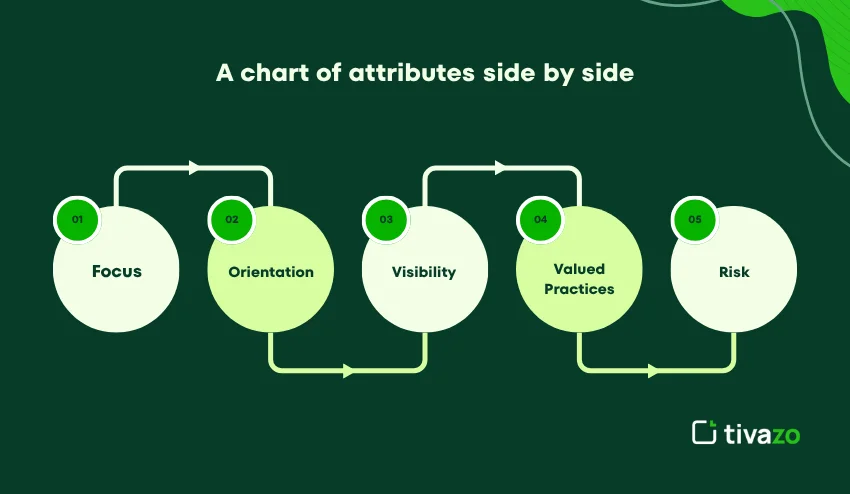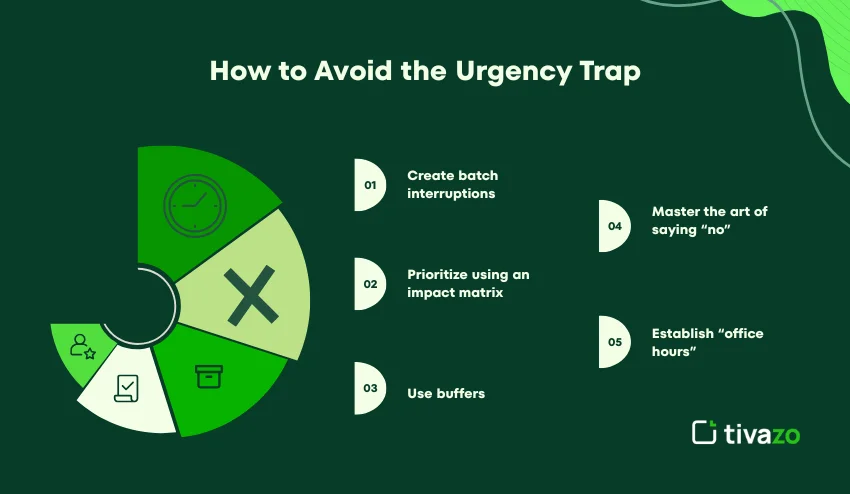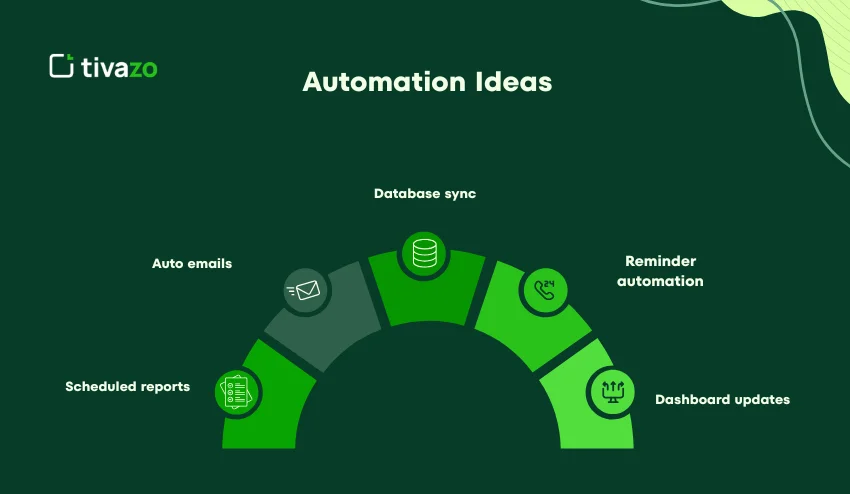Have you ever had a busy work day with a lot going on, but didn’t really accomplish anything? A lot of people in a professional setting fall victim to the busy work trap, where they are inundated with work that appears to be important and urgent, yet it provides almost zero real value. We’ll examine exactly what the busywork trap is, the relationship to micromanaging behaviour, and how to avoid the busywork trap itself.
Let’s dive right in, and by the end, you’ll have a very thoughtful roadmap to avoid the busy work trap in your own work life, identify activities that drain your time, and replace them with a purposeful action, as well as engineer your work life to support focus, clarity, and outcomes, not useless busyness.
What Is “Busy Work”? The Busywork Trap Defined
Definition & origins
“Busy work” describes tasks that create an illusion of worth, while in reality, deliver little or nothing of worth or substance.
Individuals, or whole teams, who continually engage in these tasks every day fall into the “busy work trap,” where one is busy but not productive.
The primary attributes of the busy work trap are:
- Tasks feel urgent and/or necessary, but make no progress towards the highest outcomes and actually detract from core goals.
- Activities that are low impact, repetitive, time-consuming, and where the effort and time invested are not connected to scaling efforts or results.
- It often covers the real causes of the busy work trap, such as not prioritizing well or not having clarity on deliverables, and those things, while important, are hidden behind the number of activities engaged in for the day.
One’s calendar is full of activity, but no meaningful strategic progress throughout the day.
Why the busy work trap exists.
- We love checking the box: It feels low risk, and this work feels low resistance.
- Organizations reward “busyness” or being present versus having an outcome delivered.
- It lacks clarity around what is expected versus unintentionally defaulting to fillers.
- Psychological comfort: busy work trap makes us feel like we are doing something.
- Micromanagement and lack of trust create busy work tasks to monitor and maintain some control over others.
As a result of these reasons, the busy work trap can hide in plain sight.
Examples of Busywork in the Workplace
Here are common examples of tasks that reinforce the busywork trap:
| Example | Why is it Busywork | What it Covers up |
| Creating elaborate reports no one reads | High effort, low consumption | Lack of data-informed decision-making |
| Internal meetings that go on forever with no agenda | Spend time talking, not doing | Poor follow-through of meeting objectives |
| Document/slide reformatting | Do not work on content, just cosmetic changes | Avoiding substantive work |
| Responding to every email right away | Thinking email is a battle to see who is the “most responsive” to email | Poor communication prioritization |
| Tracking trivial metrics or KPIs | Spend more time measuring the metric as opposed to the outcome | Unclear on what is important |
| Copying data from one tool to another | Unproductive, mechanical work | Process inefficiencies |
These tasks feel “safe” to do, they have an appearance of productivity, and usually, these tasks take up scarce time and precious cognitive energy that could be spent on high-value work. People have a hard time getting out of these tasks, as busywork gives you immediate feedback for checking it off the list, even though it does not necessarily get you closer to your strategic goals.
When busywork becomes a daily habit of low-value work, it can lead to burnout, frustration, and lower levels of motivation, and reinforce the busywork trap. Identifying these specific tasks (and making a habit of pursuing high-value work) is critical to reclaiming purposeful productivity.
Busywork VS Productivity

Recognizing the distinction is paramount to escaping the busywork trap.
Busywork is based on tasks, driven by response, and unrelated to goals, leading to the feeling of success but not accomplishment.
Productive work is based on outcomes, driven by strategy, and related to goals, so efforts align with achievements for both business and personal purposes.
As one writer puts it: “Busy work is often masked as productive work, but it doesn’t produce a money-making or essential result.” — Rocking Your Path with Kat Sturtz
A chart of attributes side by side
| Attribute | Busy Work | Productive Work |
| Focus | Output (for example, checklists) | Outcome (impact in relation to goal) |
| Orientation | Reactive, urgent | Pro-active, strategic |
| Visibility | Visible Task | Usually behind the scenes and leveraged or potentiated practice |
| Valued Practices | Doing many things | Doing a few things that produce value |
| Risk | Burnout low morale | Sustainable momentum, clarity |
Many employees and teams confuse busyness with productivity. Often, busy work trap appear immediate, measurable, and linked to or related to the completion of tasks, sending many updates, attending many meetings, etc. Little attention to long-term goal attainment occurs in any of these practices. In contrast, productive work may be less noticeable in the moment but generates results over many iterations. Recognizing the difference is important for leaders or individuals restructuring workflow, differentiating high-impact work, and preventing the busy work trap, value. time in working, busy wasted time.

Ways to Break Out of the Productivity Trap (aka, the Busywork Trap)
Here is a set of techniques for getting out of the busy work trap and stepping into true productivity.
1. Complete a Time Audit
Document everything you do for 1-2 weeks. Then, categorize each task as:
- Strategic/high value
- Necessary (admin)
- Busywork
Then, look for patterns and identify time vacuums! This step is crucial to understanding how far the busy work trap has crept into your thinking in terms of productivity, as well as the larger team workflow.
2. Ask the hard questions
For every task that you repeat, consider:
- Does this matter?
- Who does this serve in terms of outcomes?
- Can this be eliminated, delegated, automated, or minimized?
If you continue to answer “no” to these questions, then the task is certainly contributing to the busy work trap.
3. Set goals with outcomes
Create a swap from “tasks completed” to “outcomes achieved.” For example, instead of “write 5 slides”, state “receive leadership approval on the proposal.” Stating goals with intended outcomes helps reduce the possible space for the busywork trap to flourish.
4. Delegate or outsource
Pass on the non-core skill task. You can delegate formatting, rote data entry, and other routine updates. Hold on to your time for strategic activities. This also helps escape the busy work trap at the team and organization level. Considering your time of productivity will improve clarity.
5. Automate repetitive responsibilities
Implement tools and processes that will result in less busy work trap. Here are a few examples:
- Automated reports
- Email templates
- Zapier, Integromat / Make workflows
- RPA for data transfers
These tactics lessen the threat of the busy work trap.
6. Run meetings with discipline
- Only meet when you have to
- Always have an agenda + roles
- Time-box each conversation
- Have action items to end the discussion
- Poor meetings are a breeding ground for the busy work trap.
7. Block “deep work” time
Designate 1 to 2 hours of uninterrupted time each day for your high-leverage work (strategy, planning, deep thinking). Keep this time sacred – everything else is optional or delegable.
How to Avoid the Urgency Trap
The “urgency trap” is usually what is responsible for the busywork trap. Everything calls out “do this now,” so we fill our day with reactive, “urgent” responsibilities that are not meaningful.
Ways to avoid it
- Create batch interruptions: Instead of responding immediately, check email, Slack, or phone calls at set times.
- Prioritize using an impact matrix: Distinguish between what is urgent and what is important so you know what to focus on.
- Use buffers: Schedule breaks into your day to catch up, reflect, or think about strategy.
- Master the art of saying “no”: Push back against non-essential requests that prompt urgent but unimportant activities.
- Establish “office hours”: Let your team know when to make requests instead of always being on request.
Additionally, the more you plan your day the night before, while also placing potty blocks for projects that are a high priority, will encourage you to minimize your impulse reactions. Revisit priorities regularly to ensure that you are not blown away by minor urgencies. Avoiding the urgency trap feeds the busy work trap, creates more focus, and gives back hours to spend on activities that generate results and productivity over the long haul.

Automating Tasks
Automation is one of the best protections against busywork, enabling the elimination or reduction of repeatable tasks and more time available for high-value work.
Where to start
1. Write down repeatable tasks, daily, weekly, or monthly. Identify activities that tie up time/personal resources without using any creative thinking.
2. Map process steps. This requires documenting each micro step to more fully recognize what the workflow looks like before you automate.
3. Identify automation tools. This can range from no-code platforms to low-code tools like Zapier, to programming simple scripts to automate.
4. Test and iterate. The idea with any automation is that you are streamlining the tasks in a more efficient process.
5. Monitor and maintain. Technology gets better with time, and functionality gets better; revisit your automation process frequently.
Automation Ideas
1. Automated report generation is scheduled to occur versus manual generation.
2. E-mail sequence creation and auto responders for routine business communications e-mails.
3. Synchronizing databases or CRMs to eliminate redundancy in entering data.
4. Automated reminder features for timely follow-ups, reducing any scope for oversight.
5. Scheduled dashboard updates via applications like APIs, providing real-time updates and opportunities.
Using automation saves time but often provides a more accurate process without the human error associated with the busy work trap. Strategically implementing automation will allow you to save hours each week, refocus your efforts on pieces of work that matter, while protecting time and energy given to things that cause busywork.

Sample Workflow for Getting out of the Busywork Trap
Here’s a sample weekly workflow for implementing these practices and progressively escaping the busywork trap:
| Day | Task | Focus |
| Monday AM | Time audit review + flag top 3 busywork | Awareness |
| Monday PM | Automate one repetitive process | Action |
| Tuesday | Deep work block (strategic planning) | High leverage |
| Wednesday | Delegate non-core tasks | Elimination |
| Thursday | Meeting audit & cancel meetings that aren’t needed, or you don’t have time. | Optimize |
| Friday | Reflect, refine, and plan for the week ahead | Continuous Improvement |
As you can see, these are practically invisible little shifts, but after 60 days or so, they will chip away at your busywork trap, swapping out those low-value tasks for activities that will have a high impact. It’s also helpful to regularly measure your outcomes, however big or small, over the week, so you have a sense of accomplishment.
I encourage you to have your team follow something similar to create a workflow culture to be more effective and to be more focused. By adding this structure to your workflows, you and your team will reclaim mental bandwidth, reduce stress, and see the value of your work turn into something measurable, versus just doing. You’ll create a space where productivity becomes more about the outcomes versus activity.
Conclusion
The busywork trap is characterized by spending time on tasks that seem to be important, immediate, or urgent but generate little or no real value. Busywork is often associated with micromanagement and poor prioritization, and this can be harmful to both productivity and morale. By defining busywork, using more productive work practices, auditing the tasks we complete, automating repetitive and low-value tasks, and incorporating deep work practices, individuals and teams can break free from the busy work trap.
Purposefully avoiding the urgency trap and instituting structured work habits allows you to manage effort toward valuable activities. You can break free of the busywork trap with conscious and consistent effort and achieve true productivity and measurable results.




